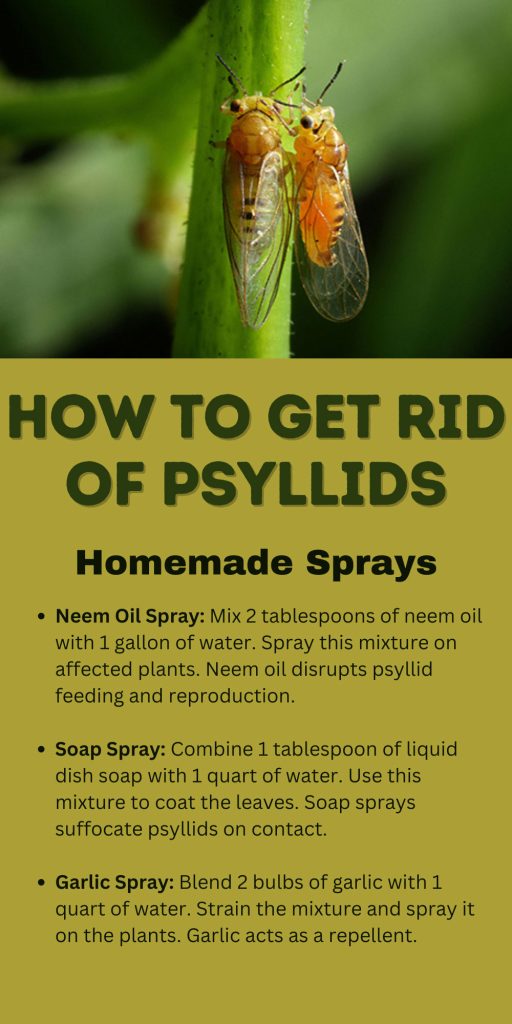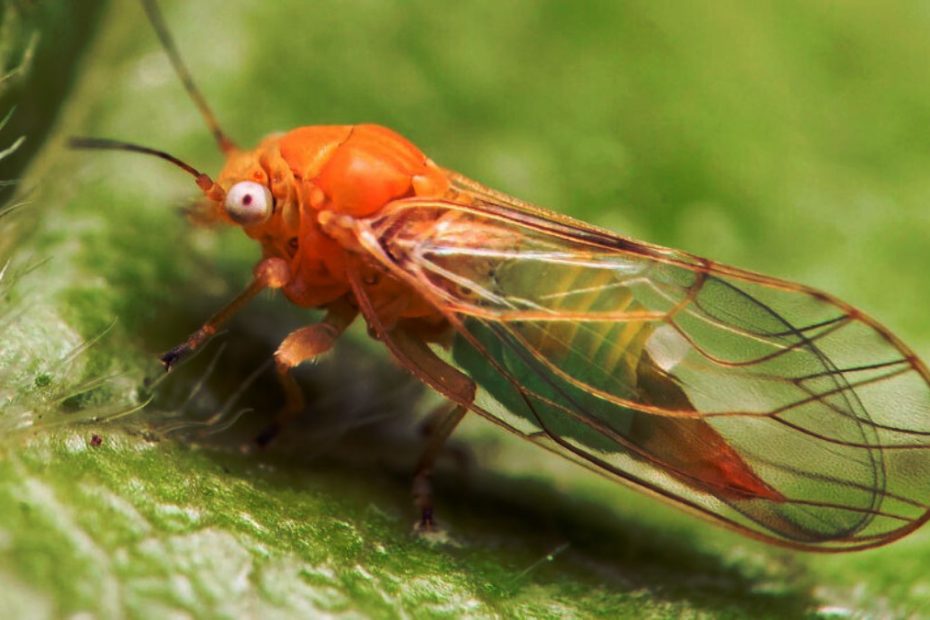Psyllids might be tiny, but they can wreak havoc on your garden if left unchecked. These sap-sucking insects not only damage plants by feeding on their juices but also spread diseases that can devastate your greenery. If you’ve noticed curled leaves, yellowing foliage, or a sticky residue on your plants, it’s time to take action.
Getting rid of psyllids doesn’t have to be a challenging job. With the right strategies, you can protect your plants and restore your garden’s health. In this guide, you’ll discover effective methods to identify, control, and prevent psyllid infestations, ensuring your garden thrives all season long.
Key Takeaways
- Understand Psyllids: Psyllids are tiny, sap-sucking insects that damage plants and spread diseases. Recognizing their signs, such as leaf curling, yellowing foliage, and sticky residue, is crucial for early intervention.
- Prevention Strategies: Regularly monitoring plants, choosing resistant varieties, and incorporating a mix of plant species can effectively prevent psyllid infestations and promote a healthier garden environment.
- Natural Control Methods: Utilizing beneficial insects and homemade sprays (like neem oil, soap, and garlic sprays) can help manage psyllid populations without introducing harmful chemicals, maintaining a balanced garden ecosystem.
- Chemical Control Methods: When natural methods are insufficient, chemical insecticides (systemic, contact, IGRs, and horticultural oils) offer targeted solutions. Adhering to safe application practices is essential for minimizing harm to beneficial organisms and the environment.
- Long-Term Management: Implementing Integrated Pest Management (IPM) and adhering to seasonal care tips ensures sustainable control of psyllids, fostering a resilient and thriving garden year-round.

Understanding Psyllids
Psyllids are sap-sucking insects that can damage plants and spread diseases in gardens. Knowing what they are, their types, and signs of infestation helps you protect your plants.
What Are Psyllids?
Psyllids, also known as plant lice, belong to the superfamily Psylloidea.
- Description: Small, winged insects measuring 1-5 mm.
- Diet: Feed on plant sap.
- Behavior: Cause leaf curling and yellowing.
Common Types of Psyllids
Different psyllid species affect various plants.
- Asian Citrus Psyllid: Targets citrus trees, spreading Huanglongbing disease.
- Tomato-Potato Psyllid: Damages solanaceous crops like tomatoes and potatoes.
- Pear Psyllid: Infests pear trees, causing sooty mold growth.
Signs of Psyllid Infestation
Identifying pest activity early can save your plants.
- Leaf Curling: New leaves appear twisted or curled.
- Honeydew Residue: Sticky substance on leaves or stems indicating sap consumption.
- Yellowing Foliage: Leaves turning yellow or exhibiting mottled patterns.
Recognizing these indicators allows for timely intervention to prevent damage and disease spread.
Prevention Strategies
Effective prevention strategies for psyllids can help protect your garden from these damaging pests. By implementing these methods, you can reduce the risk of infestations and maintain healthy plants.
Regular Monitoring
Regular monitoring is essential for early detection of psyllid activity.
Key Practices:
- Inspection Frequency: Check plants weekly for signs of psyllid presence.
- Visual Cues: Look for curled leaves, yellowing foliage, and sticky residue.
- Plant Variety: Inspect a variety of plants, especially those known to attract psyllids.
Examples include citrus trees and potato plants. Early detection aids in timely intervention and reduces the spread of pests.
Choosing Resistant Plants
Selecting resistant plant varieties is a proactive way to prevent psyllid infestations.
- Research: Identify plant species and cultivars known for psyllid resistance.
- Local Sources: Consult local nurseries and agricultural extensions for recommendations.
- Diverse Planting: Incorporate a mix of resistant plants to discourage widespread pest colonization.
Examples of resistant species include certain citrus varieties and specific ornamental plants. Choosing these plants can significantly reduce the likelihood of psyllid problems.
Implementing these prevention strategies ensures a healthier garden environment and minimizes the impact of psyllids on your plants.
Natural Control Methods
There are several natural control methods to combat psyllids, focusing on environmental balance and minimal chemical use. Implementing these methods can help maintain a healthy garden ecosystem.
Beneficial Insects
Introducing beneficial insects can effectively reduce psyllid populations. These natural predators can keep pest numbers in check.
- Ladybugs: Known for consuming aphids, ladybugs also feed on psyllid nymphs and eggs.
- Lacewings: These insects target various soft-bodied pests, including psyllid larvae.
- Parasitic Wasps: Species like Tamarixia radiata specifically target psyllid nymphs, laying eggs inside them.
Creating a habitat for these beneficial insects involves planting nectar-rich flowers and minimizing pesticide use, ensuring predators can thrive and manage psyllid infestations.
Homemade Sprays
Homemade sprays provide a chemical-free option for controlling psyllid populations. These sprays can deter psyllids and reduce their numbers on affected plants.
- Neem Oil Spray: Mix 2 tablespoons of neem oil with 1 gallon of water. Spray this mixture on affected plants. Neem oil disrupts psyllid feeding and reproduction.
- Soap Spray: Combine 1 tablespoon of liquid dish soap with 1 quart of water. Use this mixture to coat the leaves. Soap sprays suffocate psyllids on contact.
- Garlic Spray: Blend 2 bulbs of garlic with 1 quart of water. Strain the mixture and spray it on the plants. Garlic acts as a repellent.
Use these sprays in the early morning or late afternoon to avoid intense sunlight, ensuring the effectiveness and safety of the treatments for your plants.
Implementing these natural control methods can significantly reduce psyllid populations without introducing harmful chemicals, promoting a balanced and healthy garden ecosystem.
Chemical Control Methods
Chemical control methods can effectively manage psyllid infestations when used correctly. This section explains different types of insecticides and safe application practices to ensure the efficient and safe use of these chemicals.
Types of Insecticides
Various insecticides target psyllids, each with specific properties and applications. Below are some common types:
- Systemic Insecticides: These are absorbed by plant tissues, making the plant itself toxic to the psyllids feeding on it. Examples include imidacloprid and thiamethoxam.
- Contact Insecticides: These kill psyllids on direct contact. When applied, psyllids must come into contact with the residue to be effective. Examples are pyrethroids and carbamates.
- Insect Growth Regulators (IGRs): These disrupt the life cycle of psyllids by inhibiting growth and development, such as pyriproxyfen.
- Horticultural Oils: These smother psyllids and their eggs, making them excellent for targeting nymph stages. Petroleum-based and neem oils are examples.
Safe Application Practices
Applying insecticides safely ensures effectiveness and minimizes harm to other organisms and the environment. Follow these best practices for safe application:
- Read Labels: Always read and follow the instructions on the insecticide label. It provides critical information on dosage, application methods, and safety precautions.
- Use Protective Gear: Wear gloves, masks, and protective eyewear to avoid exposure to chemicals.
- Target Specific Areas: Apply insecticides directly to affected areas to reduce the impact on beneficial insects and avoid unnecessary chemical use.
- Avoid Windy Conditions: Apply in calm conditions to prevent drift, which can affect non-target areas and organisms.
- Adhere to Timing: Apply insecticides at times when psyllids are most active and ensure proper intervals between applications, as specified on the label.
- Dispose Properly: Follow guidelines for the disposal of chemical containers and unused insecticides to prevent environmental contamination.
Using chemical control methods thoughtfully and responsibly can help manage psyllid populations without causing harm to your garden ecosystem.
Long-term Management
Effectively managing psyllids over the long term involves a combination of strategies that maximize plant health and resilience while minimizing pest populations. Implementing integrated pest management and seasonal care tips can ensure sustainable garden health.
Integrated Pest Management
Integrated Pest Management (IPM) combines different management approaches to control psyllids effectively. It relies on monitoring, biological control, and chemical methods to keep psyllid populations under control.
Key Components of IPM:
- Monitoring: Regularly inspect plants for psyllid activity. Look for signs like curled leaves and sticky residue.
- Biological Control: Introduce beneficial insects (e.g., ladybugs and lacewings) to control psyllid populations.
- Chemical Methods: Use insecticides judiciously. Follow safe application practices to minimize harm to beneficial insects and the environment.
- Cultural Practices: Maintain plant health through proper watering, pruning, and fertilization. Remove infested plant parts promptly.
By combining these components, you can create a balanced approach to managing psyllids that is effective and environmentally friendly.
Seasonal Care Tips
Paying attention to seasonal changes ensures proactive psyllid management. Different measures are necessary depending on the time of year.
Spring and Summer:
- Monitoring: Increase the frequency of plant inspections, as psyllid activity typically rises with warmer weather.
- Beneficial Insects: Release beneficial insects early in the season to establish a natural predator population.
- Homemade Sprays: Apply neem oil or soap sprays to plants as a preventive measure.
Fall and Winter:
- Pruning: Remove and dispose of heavily infested or damaged plant parts. This reduces overwintering psyllid populations.
- Soil Health: Add compost to improve soil health and plant resilience against pests.
- Dormant Oils: Apply horticultural oils to dormant plants to target overwintering psyllids.
Following these seasonal tips helps reduce psyllid populations and promotes overall garden health throughout the year.
Conclusion
Taking proactive measures to protect your garden from psyllids is essential for maintaining plant health. Regular monitoring, choosing resistant plant varieties, and introducing beneficial insects can significantly reduce psyllid populations. Natural control methods like homemade sprays and creating habitats for beneficial insects offer effective, eco-friendly solutions.
When necessary, using chemical control methods responsibly ensures minimal harm to your garden ecosystem. Implementing Integrated Pest Management (IPM) strategies provides a comprehensive approach to long-term psyllid management. By following these guidelines, you’ll keep your garden thriving and resilient against psyllid infestations.
Frequently Asked Questions
What are psyllids and why are they a problem for gardens?
Psyllids are small sap-sucking insects that can damage plants and spread diseases. They cause symptoms like curled leaves, sticky residue, and yellowing foliage, which can harm plant health and productivity.
How can I recognize a psyllid infestation in my garden?
Common signs of a psyllid infestation include curled leaves, the presence of sticky residue (honeydew), and yellowing foliage. Regular inspections help detect these symptoms early.
Which types of psyllids are most common in gardens?
Common types of psyllids in gardens include the Asian Citrus Psyllid, Tomato-Potato Psyllid, and Pear Psyllid. Each targets specific plants, so knowing the affected species can aid in identification.
What are the main prevention strategies for psyllid infestation?
Effective prevention strategies include regular monitoring and weekly inspections of susceptible plants. Choosing resistant plant varieties also helps prevent infestations.
Are there natural methods to control psyllids?
Yes, natural control methods include introducing beneficial insects like ladybugs, lacewings, and parasitic wasps. Homemade sprays using neem oil, soap, and garlic can also help manage psyllid populations.
When should chemical control methods be used?
Chemical control methods should be considered when infestations are severe and natural methods are insufficient. However, use insecticides responsibly, following label instructions and safety guidelines.
What are Integrated Pest Management (IPM) strategies for psyllids?
IPM combines regular plant inspections, biological controls, and judicious chemical use to manage psyllid populations effectively while maintaining plant health and minimizing environmental impact.
What seasonal care tips help manage psyllid populations?
Increase monitoring and introduce beneficial insects in spring and summer. In fall and winter, focus on pruning and improving soil health to reduce psyllid habitats and support plant resilience.
